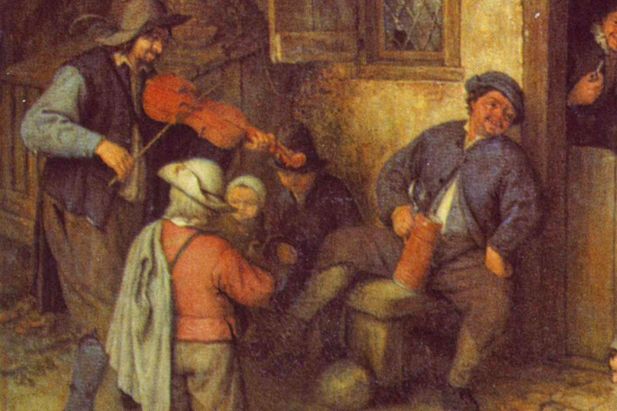


| |
Adriaan van Ostade   
At the beginning of the 17th century there was settled at Haarlem one Jan Hendricx, who, driven away possibly by the fear of military strife and religious persecutions, had come from the town of Eindhoven, a neighbourhood famous for the production of cloth; he was in all probability a weaver.
Early in 1605 we find him settled at Haarlem, and married to Janneke Hendericdr of Wonsel (Daughter of Henry. + i.e. "Woensel"), a village near Eindhoven. The marriage was a fruitful one; they had eight children four girls and four boys whom they were able to bring up in ease, if not in luxury.
In 1610 their eldest son the third child was born, and on the 10th of December of the same year he was baptized, receiving the name of Adriaan. This was Adriaan van Ostade. The sobriquet, Van Ostade, was adopted by the children at various times in their several careers. We do not find it mentioned in connection with Adriaan Jansz until 1636, in which year he is recorded as a member of the Civic Guard, in the company known as the "Oude Schuts." The name, Ostade, was derived from a small hamlet called Ostade, probably the birth-place of their father, near Eindhoven. As Adriaan signed himself Van Ostade on almost all his works, it has, not unnaturally, been looked upon as a surname.
Adriaan left to his brother Johannes the trade of weaving, while he and the youngest child, Isack, adopted the profession of art. He entered the studio of Frans Hals, and was there a fellow student of Adriaen Brouwer. On the completion of his apprenticeship he set up as a painter in his native town, and there he lived in good circumstances, laboured with industry, and died respected.
In 1638 he married Machtelgen Pietersen, a young lady, a native of Haarlem; but fate did not permit him to enjoy many years of unalloyed happiness. Sorrows fell fast upon him. In 1640 his mother died; in the following year he lost his father; and in 1642 his young wife was taken from him, after a short wedded life of but little more than four years. That he married again has been ascertained, though history is silent as regards the name of his second choice. Again he was left a widower, in 1666.
On the 27th of April, 1685, in the Nieuwe Kruysstraet, Adriaan Jansz died; and on the 2nd of May he was buried in the Church of St. Bavo, where he had previously laid the remains of his two wives. In June of the same year a sale took place of the works of art left at his death they included, besides the paintings of other masters, two hundred pictures by his own hand, his etchings, drawings, etc.
His son-in-law, Dirk van der Stoel, surgeon of Haarlem the husband of his only child Johanna Maria appears to hove bought the etchings, for in the July he held a sale of them.
Van Ostade has left a name which although he seldom painted subjects more ambitious than peasants and scenes from out "the short and simple annals of the poor" is among the most distinguished of the Dutch figure painters.
Adriaan van Ostade is a kind of "Rembrandt in little." Certainly he approaches nearer to the great masters, as a colourist, than even Gerard Dou himself, and also in the management of his transparent shadows; occasionally even he produces in his pictures those deep golden tones for which Rembrandt is celebrated, and his power of grouping his figures is also Rembrandtesque.
Adriaan worked at a period when the Dutch school had reached its zenith, when Gerard Dou was making those wondrous gems which have been the envy and despair of his imitators, when Paulus Potter was giving more life to his horses and cattle than any artist had till that day attempted, and which no animal painter equalled until Edwin Landseer came; and high above all these lesser lights blazed the prodigious genius of the son of the Leyden miller, the greatest master of light and shadow that the world of art has produced.
The affinity between some of Van Ostade's interiors and those of Rembrandt have not unnaturally made writers en Dutch art suppose that Adriaan worked among the Great
Master's pupils. This, however, was not the case. Van Ostade certainly caught somewhat of the magic power; some of the splendid colouring of Rembrandt. In many of Van Ostade's interiors the lights and shadows are as subtly managed as even in those of Rembrandt; look, for instance, at a picture of the old hall in which Van Ostade has shown us himself at work before his easel, how the darkness of this cloistered apartment can be felt j only one
window admits the light through its narrow panes of glass, to fall brokenly in a hundred chequers on the old stone floor; in the dim distance beneath the winding staircase an apprentice is grinding the artist's colours. Is not Rembrandt's influence strongly marked in such a work?
Or look again at the interior of this old barn, in which peasants are carousing. Was ever such a common old building made to glow with light and shade as this does, and is it not almost worthy of Rembrandt's brush?
Although Van Ostade owing probably to the taste of his patrons more than to his own inclination nearly always painted scenes of ruffianism and drunkenness, of boors fighting over their cups, etc., his own life was essentially a gentle and a decent one. To judge by the portrait he has left us of himself, painted when in middle life, he resembled rather a Covenanting preacher or a Methodist person than the painter of brawls and junketings. He wears his hair long, falling over a plain deep collar.
| |
|















